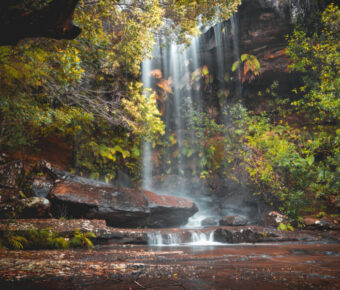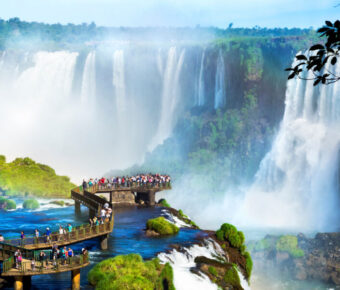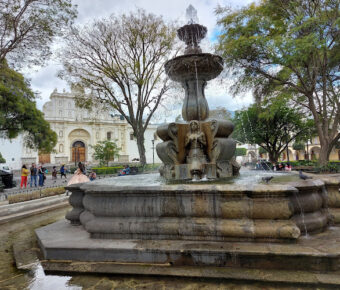
18 Breathtaking Places to Visit Along the Danube River
The mighty Danube River stretches nearly 1,800 miles across Europe, weaving through ten countries and four capital cities, creating one of the world’s most enchanting waterways. As the second-longest river in Europe, the Danube has been a crucial trade route since Roman times and continues to captivate travelers with its stunning landscapes, medieval towns, and vibrant cultural capitals.
For 2025 travelers, the Danube offers an unparalleled opportunity to experience the heart of Europe through its diverse cities, UNESCO World Heritage sites, and breathtaking natural wonders. Whether you’re planning a luxurious river cruise, a self-guided cycling adventure, or a personalized road trip, this comprehensive guide will help you discover the most captivating destinations along this iconic river.
Contents
- Quick Reference Guide
- 1. Budapest, Hungary – The Pearl of the Danube
- What to See in Budapest
- Insider Tip
- 2. Vienna, Austria – Imperial Grandeur on the Danube
- What to See in Vienna
- Insider Tip
- 3. Bratislava, Slovakia – Charming Capital with Medieval Roots
- What to See in Bratislava
- Insider Tip
- 4. Melk, Austria – Baroque Abbey Overlooking the River
- What to See in Melk
- Insider Tip
- 5. Wachau Valley, Austria – UNESCO-Listed Wine Country
- What to See in Wachau Valley
- Insider Tip
- 6. Passau, Germany – City of Three Rivers
- What to See in Passau
- Insider Tip
- 7. Regensburg, Germany – Medieval River Trading Hub
- What to See in Regensburg
- Insider Tip
- 8. Linz, Austria – From Industrial Past to Cultural Present
- What to See in Linz
- Insider Tip
- 9. Belgrade, Serbia – Vibrant Balkan Capital at the Rivers’ Junction
- What to See in Belgrade
- Insider Tip
- 10. Novi Sad, Serbia – European Capital of Culture
- What to See in Novi Sad
- Insider Tip
- 11. Ruse, Bulgaria – Little Vienna on the Danube
- What to See in Ruse
- Insider Tip
- 12. Dürnstein, Austria – Fairy-Tale Village in the Wachau Valley
- What to See in Dürnstein
- Insider Tip
- 13. Drobeta-Turnu Severin, Romania – Gateway to the Iron Gates
- What to See in Drobeta-Turnu Severin
- Insider Tip
- 14. Vilshofen, Germany – Charming Bavarian Town
- What to See in Vilshofen
- Insider Tip
- 15. Krems, Austria – Gateway to the Wachau Valley
- What to See in Krems
- Insider Tip
- 16. Izmail, Ukraine – Danube Delta Gateway
- What to See in Izmail
- Insider Tip
- 17. Esztergom, Hungary – Spiritual Center of Hungary
- What to See in Esztergom
- Insider Tip
- 18. Vukovar, Croatia – City of Resilience
- What to See in Vukovar
- Insider Tip
- Planning Your Danube Journey
- Best Time to Visit
- How to Travel the Danube
- Practical Tips for Danube Travelers
- More Travel Guides
Quick Reference Guide
| Best Time to Visit | Popular Travel Methods | Top Cities | Hidden Gems |
|---|---|---|---|
| April-June & September-October | River cruises, cycling, road trips | Budapest, Vienna, Bratislava | Dürnstein, Melk, Passau |
| Average Trip Length | Budget Range (USD) | Must-See Attractions | Best For |
| 7-14 days | $1,500-$5,000+ | Budapest Parliament, Vienna’s Hofburg Palace, Wachau Valley | History lovers, architecture enthusiasts, food & wine connoisseurs |
1. Budapest, Hungary – The Pearl of the Danube

Budapest stands as one of Europe’s most visually striking capitals, earning its nickname “Pearl of the Danube” with good reason. The city is uniquely split by the river into two distinct areas – hilly Buda and flat Pest – each offering completely different experiences.
What to See in Budapest
- Parliament Building: This neo-Gothic masterpiece is perhaps Budapest’s most iconic landmark, especially when illuminated at night. Take an evening cruise to see it in all its golden glory reflected on the water.
- Fisherman’s Bastion: Located on the Buda side, this fairytale-like terrace offers panoramic views across the Danube to Pest.
- Chain Bridge: Walk across this historic suspension bridge connecting the two sides of the city for stunning river views.
- Thermal Baths: Experience Budapest’s famous bath culture at the magnificent Széchenyi or art nouveau Gellért Thermal Baths.
- Shoes on the Danube Bank: A moving memorial to Holocaust victims along the river’s edge.
Insider Tip
For a unique perspective of Budapest, climb Gellért Hill at sunset for breathtaking views of both sides of the city and the majestic Parliament Building as it lights up for the evening.
2. Vienna, Austria – Imperial Grandeur on the Danube
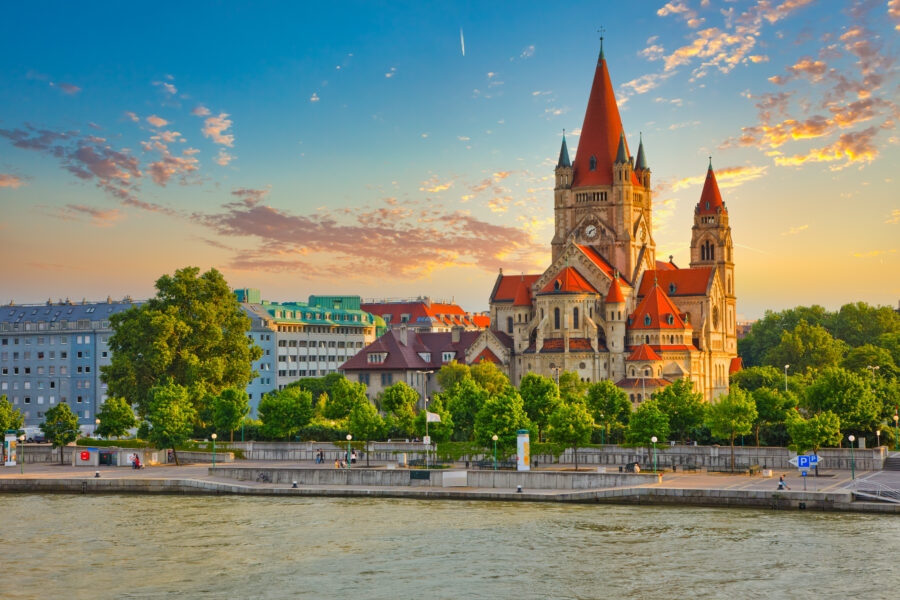
Vienna embodies European elegance with its imperial architecture, world-class museums, and rich musical heritage. As the longtime capital of the Habsburg Empire, Vienna’s cultural influence spreads far beyond its borders.
What to See in Vienna
- Hofburg Palace: The former imperial palace complex houses museums, the Spanish Riding School, and the Austrian National Library.
- St. Stephen’s Cathedral: This Gothic masterpiece dominates Vienna’s skyline with its distinctive tiled roof.
- Belvedere Palace: Visit this baroque palace to see Gustav Klimt’s famous painting “The Kiss.”
- Vienna State Opera: Experience world-class performances in one of Europe’s most prestigious opera houses.
- Café Culture: Take time to experience Vienna’s historic coffee houses, such as Café Central, where intellectuals like Freud and Trotsky once debated.
Insider Tip
Vienna is synonymous with classical music. Consider booking a concert at the ornate Musikverein concert hall or attending a more intimate chamber music performance in one of the city’s historic churches.
3. Bratislava, Slovakia – Charming Capital with Medieval Roots
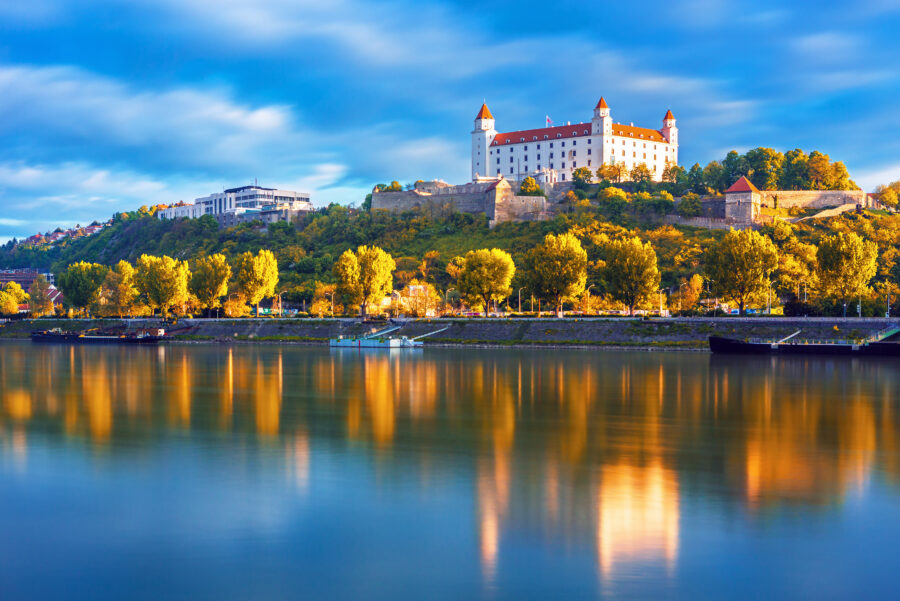
Just an hour downstream from Vienna lies Bratislava, Slovakia’s compact capital city. With its beautifully preserved Old Town and commanding castle, Bratislava offers a more intimate Danube experience.
What to See in Bratislava
- Bratislava Castle: Perched high above the Danube, this restored castle provides sweeping views of the river and the old town.
- St. Martin’s Cathedral: This Gothic cathedral was the coronation church for Hungarian kings and queens for nearly three centuries.
- Michael’s Gate: The last remaining medieval gateway to the city features a tower with exhibits on the city’s fortifications.
- Old Town: Wander the pedestrian-only streets filled with cafés, restaurants, and artisan shops.
- Blue Church: Officially the Church of St. Elizabeth, this Art Nouveau gem is painted in striking pastel blue.
Insider Tip
Bratislava is often less crowded than its neighboring capitals, making it an ideal place to slow down and enjoy riverside dining at local prices. Try traditional Slovak cuisine at one of the restaurants along the Danube promenade.
4. Melk, Austria – Baroque Abbey Overlooking the River

The small town of Melk is dominated by its magnificent Benedictine abbey, which has been a spiritual and cultural center for over 900 years.
What to See in Melk
- Melk Abbey: This stunning baroque monastery perched above the town features an impressive library with medieval manuscripts, a beautiful church, and panoramic views of the Danube.
- Wachau Valley: Melk serves as a gateway to this UNESCO-listed cultural landscape known for its rolling hills, vineyards, and apricot orchards.
- Old Town: Take time to explore Melk’s charming town center with its colorful buildings and cobblestone streets.
Insider Tip
If visiting between April and October, don’t miss the abbey’s beautiful gardens, especially the Baroque Garden Pavilion with its unique frescoes.
5. Wachau Valley, Austria – UNESCO-Listed Wine Country
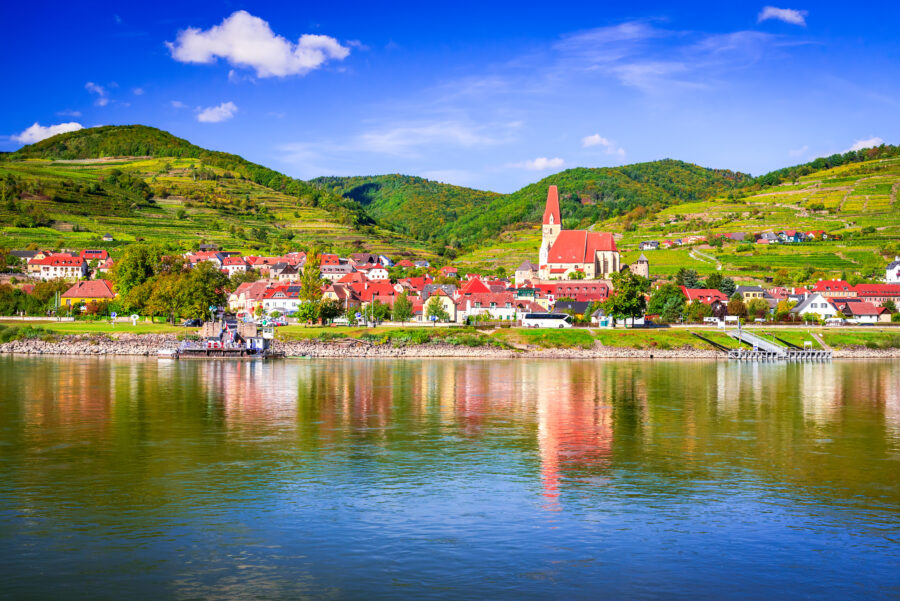
Between Melk and Krems lies the picturesque Wachau Valley, a UNESCO World Heritage site renowned for its terraced vineyards, historic villages, and castle ruins.
What to See in Wachau Valley
- Dürnstein: This storybook village is famous for its blue abbey tower and the castle ruins where King Richard the Lionheart was once imprisoned.
- Vineyards: The valley is famous for its Grüner Veltliner and Riesling wines, with numerous wineries offering tastings.
- Cycling: The flat, well-maintained paths along the Danube make this region perfect for cycling adventures.
- Aggstein Castle Ruins: These dramatic medieval ruins offer spectacular views of the Danube from their clifftop perch.
Insider Tip
Consider taking a bike tour through the Wachau Valley, stopping at small villages and wineries along the way. The 25-mile stretch between Melk and Krems offers some of the most beautiful riverside cycling in Europe.
See Related: Magnificent European Lakes to Visit
6. Passau, Germany – City of Three Rivers
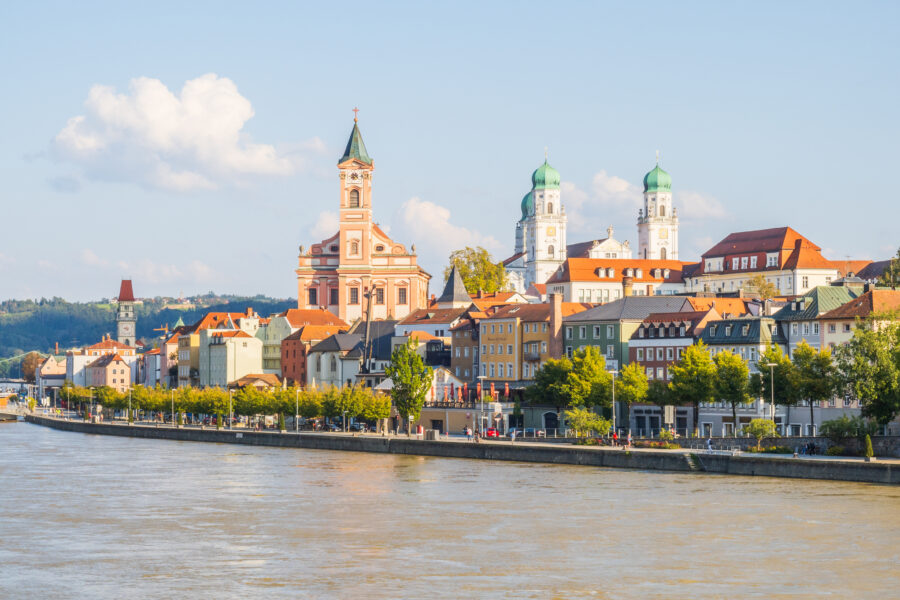
Located at the confluence of the Danube, Inn, and Ilz rivers, Passau is known as the “City of Three Rivers” and features a beautifully preserved old town.
What to See in Passau
- St. Stephen’s Cathedral: Home to the world’s largest cathedral organ, with over 17,000 pipes.
- Veste Oberhaus: This hillside fortress offers panoramic views of the three rivers converging.
- Old Town: Explore the baroque architecture and colorful buildings of Passau’s peninsula-shaped historic center.
- River Confluence: Visit the point where the three rivers meet, each with its own distinctive color.
Insider Tip
Attend one of the regular organ concerts at St. Stephen’s Cathedral to experience the magnificent sound of the world’s largest church organ in an acoustically perfect setting.
7. Regensburg, Germany – Medieval River Trading Hub

One of Germany’s best-preserved medieval cities, Regensburg boasts over 1,500 listed historic buildings and a UNESCO-protected old town.
What to See in Regensburg
- Stone Bridge: This 12th-century bridge was once considered the eighth wonder of the world.
- Regensburg Cathedral: This magnificent Gothic cathedral dominates the old town skyline.
- Historic Sausage Kitchen: Operating since the 12th century, this is one of the world’s oldest continuously open public restaurants.
- Roman Ruins: Explore remnants of the ancient Roman settlement of Castra Regina.
Insider Tip
Regensburg is known for its lively student population, giving the historic city a vibrant, youthful energy. Experience this atmosphere at one of the beer gardens along the Danube.
8. Linz, Austria – From Industrial Past to Cultural Present

Austria’s third-largest city has transformed from an industrial center to a hub of contemporary art and modern architecture.
What to See in Linz
- Ars Electronica Center: Known as the “Museum of the Future,” showcasing technological innovations and interactive exhibitions.
- Linz Castle: Housing the Upper Austrian Provincial Museum with exhibitions on the region’s cultural history.
- Hauptplatz: The main square features colorful baroque facades and the Trinity Column.
- Pöstlingberg: Take the historic mountain railway to this hill for panoramic city views and to visit the pilgrimage church.
Insider Tip
Linz is famous for the Linzer Torte, considered the world’s oldest cake recipe (dating to 1653). Visit Konditorei Jindrak to taste this delicious almond and red currant jam pastry at one of the city’s oldest bakeries.
9. Belgrade, Serbia – Vibrant Balkan Capital at the Rivers’ Junction
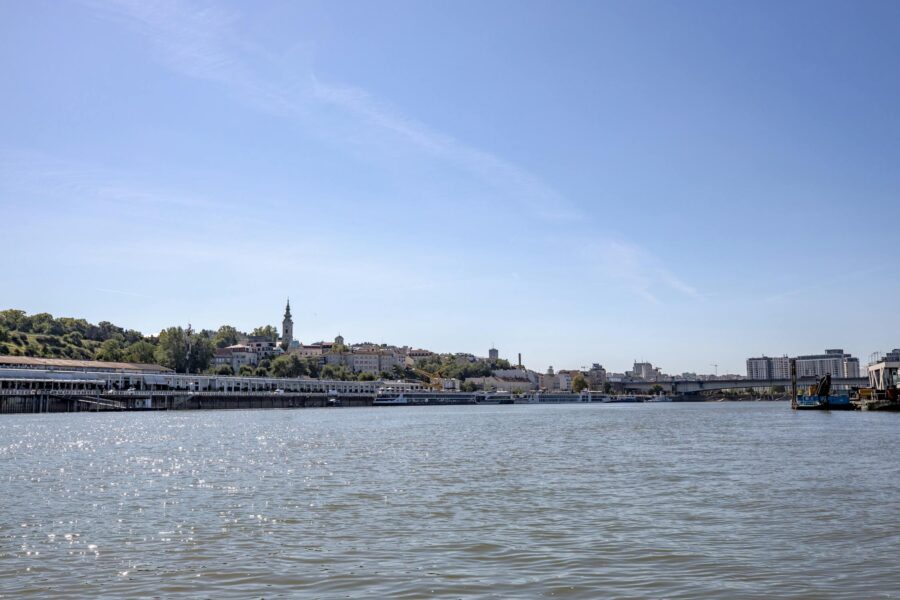
Where the Sava River meets the Danube stands Belgrade, Serbia’s dynamic capital city with a fascinating blend of Ottoman, Austro-Hungarian, and Yugoslav influences.
What to See in Belgrade
- Belgrade Fortress: This impressive complex offers excellent views over the confluence of the Sava and Danube rivers.
- Skadarlija: The bohemian quarter features traditional restaurants, live music, and a lively atmosphere.
- Church of St. Sava: One of the world’s largest Orthodox churches, with impressive mosaics inside.
- Nikola Tesla Museum: Dedicated to the famous Serbian-American inventor and engineer.
Insider Tip
Belgrade has earned a reputation as one of Europe’s most exciting nightlife destinations. Experience the city’s famous floating clubs, or “splavovi,” moored along the riverbanks for an unforgettable evening.
10. Novi Sad, Serbia – European Capital of Culture

Serbia’s second-largest city served as a European Capital of Culture in 2022 and continues to charm visitors with its relaxed atmosphere and cultural offerings.
What to See in Novi Sad
- Petrovaradin Fortress: This 17th-century fortress overlooks the Danube from a dramatic cliff.
- Stari Grad: The old town features pastel-colored Habsburg buildings arranged around tidy squares.
- Dunavska Street: A charming pedestrian area with cafés and colored façades.
- EXIT Festival: If visiting in summer, consider timing your trip with this internationally renowned music festival held at Petrovaradin Fortress.
Insider Tip
For a local experience, visit Štrand, the popular city beach along the Danube. During summer, it becomes the social hub of Novi Sad with sports activities, cafés, and relaxation areas.
11. Ruse, Bulgaria – Little Vienna on the Danube

Often called “Little Vienna” because of its Neo-Baroque and Neo-Rococo architecture, Ruse is Bulgaria’s most important river port and a gateway to Romania.
What to See in Ruse
- Freedom Square: The city’s main plaza is surrounded by elegant 19th-century buildings.
- Ruse Historical Museum: Houses the Borovo Treasure, a collection of Thracian silver dating from the 4th century BC.
- Rousse Regional Historical Museum: Located in an elegant former residence, showcasing the region’s history.
- The Rock-hewn Churches of Ivanovo: Located just outside Ruse, these UNESCO-listed medieval churches feature remarkable frescoes.
Insider Tip
Ruse is just a short drive from Bucharest, Romania, making it an excellent base for exploring both countries during your Danube journey.
See Related: Best Places to Visit in Europe This Year
12. Dürnstein, Austria – Fairy-Tale Village in the Wachau Valley

With its iconic blue church tower and ruined castle, Dürnstein is perhaps the most picturesque village in the Wachau Valley.
What to See in Dürnstein
- Dürnstein Abbey: Known for its striking blue and white tower, visible for miles along the river.
- Castle Ruins: Hike up to the fortress where Richard the Lionheart was imprisoned in the 12th century.
- Vineyards: Take a wine tour to sample the region’s excellent Grüner Veltliner and Riesling wines.
- Riverside Path: Walk or cycle along the scenic Danube path for excellent photo opportunities.
Insider Tip
For the best views of Dürnstein’s town and baroque tower, take a walk along the opposite bank of the Danube, where you can capture the postcard-perfect scene of the village against the backdrop of terraced vineyards.
13. Drobeta-Turnu Severin, Romania – Gateway to the Iron Gates
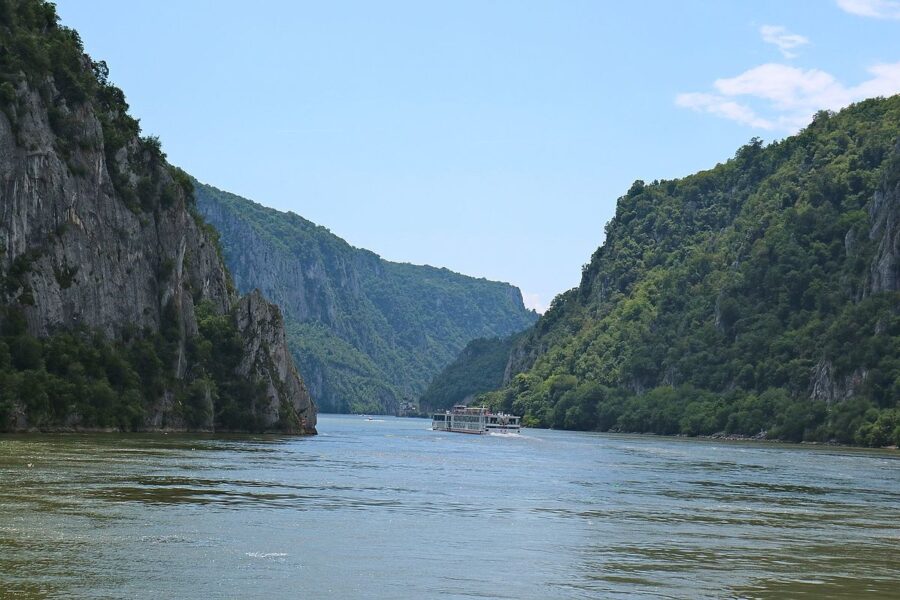
This Romanian river port city sits near the Iron Gates, an impressive gorge where the Danube cuts through the Carpathian Mountains.
What to See in Drobeta-Turnu Severin
- Iron Gates Museum: Showcases the region’s archaeology and history, including remains from the Roman bridge over the Danube.
- Medieval Fortress: Explore the ruins of the 13th-century fortress built by Hungarian kings.
- Water Tower Museum: Learn about life on the now-submerged Ada-Kaleh island before the Iron Gate dam was built.
- Iron Gates Natural Park: Take a boat trip to see the dramatic Danube Gorges, including the carved face of Dacian King Decebalus.
Insider Tip
Don’t miss a boat trip through the narrow Iron Gates gorge, where the Danube narrows dramatically between Serbia and Romania. The natural phenomenon known as the “Danube Boilers” is especially impressive.
14. Vilshofen, Germany – Charming Bavarian Town

This peaceful German town might be off the typical tourist path, but its charming old quarter and lack of crowds make it a delightful stop.
What to See in Vilshofen
- Historic Quarter: Stroll through the old-world town center with its traditional Bavarian architecture.
- Benedictine Abbey Schweiklberg: Visit this impressive monastery just outside town.
- City Tower: Climb for lovely views over the town and river.
- Hilgartsberg Castle Ruins: Explore what remains of this medieval fortress.
Insider Tip
Vilshofen hosts a traditional beer festival called “Vilshofener Bierfest” that’s much less touristy than Munich’s Oktoberfest but offers an authentic Bavarian beer garden experience.
15. Krems, Austria – Gateway to the Wachau Valley

At the eastern end of the Wachau Valley, Krems is a delightful town with a well-preserved medieval center and excellent wine culture.
What to See in Krems
- Steiner Tor: This medieval city gate is the symbol of Krems.
- Göttweig Abbey: This impressive Benedictine monastery sits on a hill overlooking the Danube.
- Kunsthalle Krems: A contemporary art museum housed in a former tobacco factory.
- Wine Tasting: Visit one of the many local wineries or heurigen (wine taverns) to sample the region’s renowned wines.
Insider Tip
Take the short trip to nearby Göttweig Abbey, which offers spectacular views of the Danube Valley and features magnificent ceiling frescoes in its imperial staircase.
16. Izmail, Ukraine – Danube Delta Gateway

This Ukrainian city near the Danube Delta provides an interesting glimpse into the eastern reaches of the river.
What to See in Izmail
- Diorama Sturm Fortress: This museum features a panoramic canvas depicting the 1790 assault on the Izmail fortress.
- Museum of the History of the Ukrainian Danube Shipping Company: Learn about the river’s importance to the region.
- Danube Promenade: Stroll along the riverfront with views across to Romania on the opposite bank.
Insider Tip
From Izmail, you can arrange excursions to explore the Danube Delta, a UNESCO Biosphere Reserve and Europe’s second-largest delta, home to over 300 bird species and diverse wildlife.
17. Esztergom, Hungary – Spiritual Center of Hungary
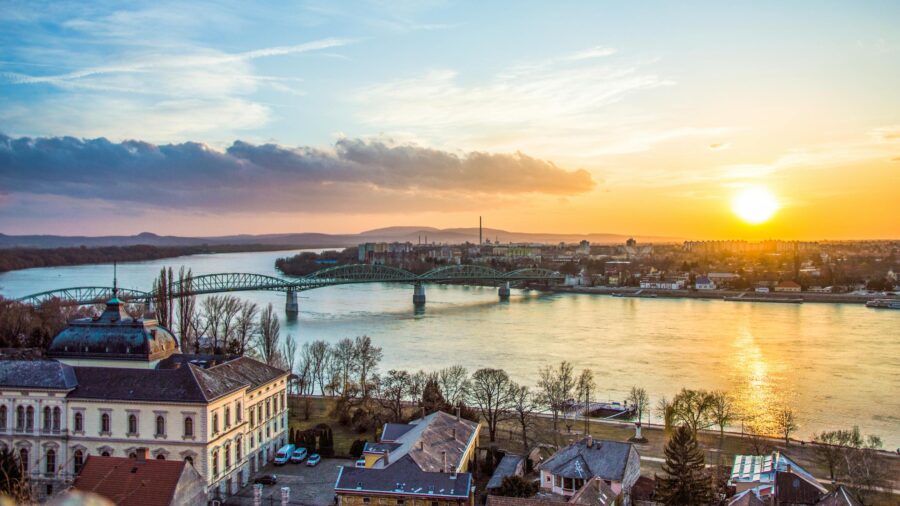
Esztergom served as Hungary’s capital from the 10th to the mid-13th century and remains the seat of the Catholic Church in Hungary.
What to See in Esztergom
- Esztergom Basilica: Hungary’s largest church and tallest building houses the world’s largest altarpiece painting.
- Castle Hill: Explore the medieval royal palace and enjoy views of the Danube and Slovakia across the river.
- Christian Museum: Houses Hungary’s largest ecclesiastical collection.
- Maria Valeria Bridge: Walk across this bridge connecting Hungary and Slovakia for great views of the basilica.
Insider Tip
Climb to the dome of the basilica for spectacular panoramic views of the Danube valley and surrounding mountain ranges. On clear days, you can see as far as Hungary, Slovakia, and Austria.
18. Vukovar, Croatia – City of Resilience
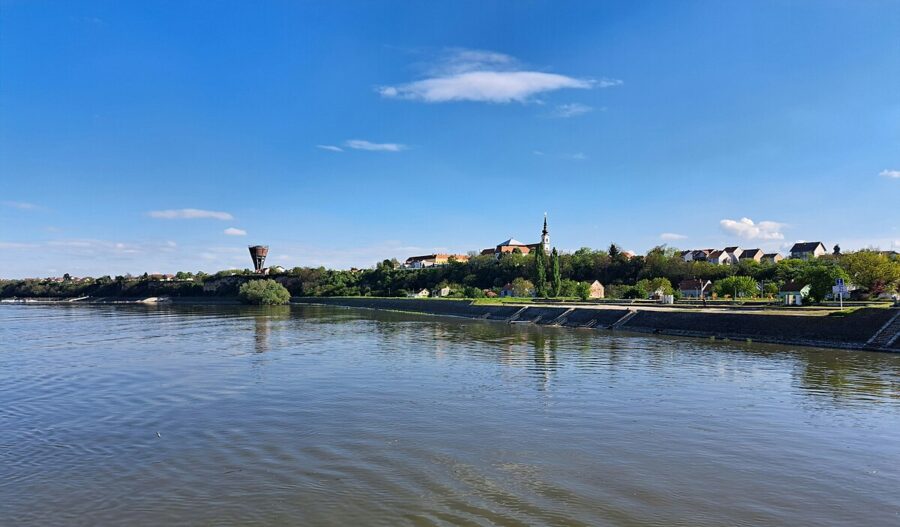
This Croatian city on the Danube has rebuilt itself after the devastating 1991 Battle of Vukovar during the Croatian War of Independence.
What to See in Vukovar
- Vukovar Water Tower: A symbol of the city’s suffering and resilience during the war.
- Franciscan Monastery and St. Philip and Jacob Church: Beautiful baroque religious buildings.
- Vučedol Culture Museum: Showcases the important Bronze Age Vučedol culture that flourished along the Danube.
- Memorial Cemetery: A moving tribute to those who lost their lives during the Croatian War of Independence.
Insider Tip
Take a boat trip from Vukovar to the Kopački Rit Nature Park, one of the largest wetlands in Europe, where the Danube and Drava rivers meet, creating a paradise for birdwatchers and nature lovers.
See Related: Breathtaking Best Beaches in Europe (With Hidden Gems!) 🏖️
Planning Your Danube Journey
Best Time to Visit
The Danube region experiences four distinct seasons, each offering a different experience:
- Spring (April-June): Mild temperatures and blooming landscapes make this an ideal time for sightseeing and outdoor activities.
- Summer (July-August): Peak season brings warm weather and longer days, but also larger crowds and higher prices.
- Fall (September-October): Harvest season in wine regions like the Wachau Valley, with pleasant temperatures and fewer tourists.
- Winter (November-March): Christmas markets enliven December, but some river cruises reduce operations during the coldest months.
How to Travel the Danube
There are several ways to experience the Danube:
- River Cruises: The most popular and comprehensive way to see multiple destinations with comfortable accommodations and guided excursions.
- Cycling: The Danube Cycle Path runs along most of the river, particularly well-developed between Passau and Vienna.
- Road Trip: Renting a car provides flexibility to explore beyond the riverside attractions.
- Public Transportation: Trains and buses connect most major cities along the Danube, offering an economical option.
- Combination Approach: Many travelers blend methods, perhaps cruising one section and cycling another.
Practical Tips for Danube Travelers
- Currency: The Danube flows through both Euro and non-Euro countries. Carry some local currency for smaller towns where card acceptance may be limited.
- Languages: While English is widely spoken in tourist areas, learning a few basic phrases in the local language is always appreciated.
- River Levels: Be aware that extreme weather can affect river levels, occasionally requiring itinerary adjustments for cruises.
- Border Crossings: While most Danube countries are in the Schengen Area, Serbia, Romania, Bulgaria, Ukraine, and Moldova are not, so carry your passport for potential checks.
- Sustainable Travel: Consider taking slower transportation, like trains or bikes, for certain segments to reduce your environmental impact.
Have you experienced the Danube’s majestic flow through Europe? Share your favorite destinations and travel tips in the comments below!

